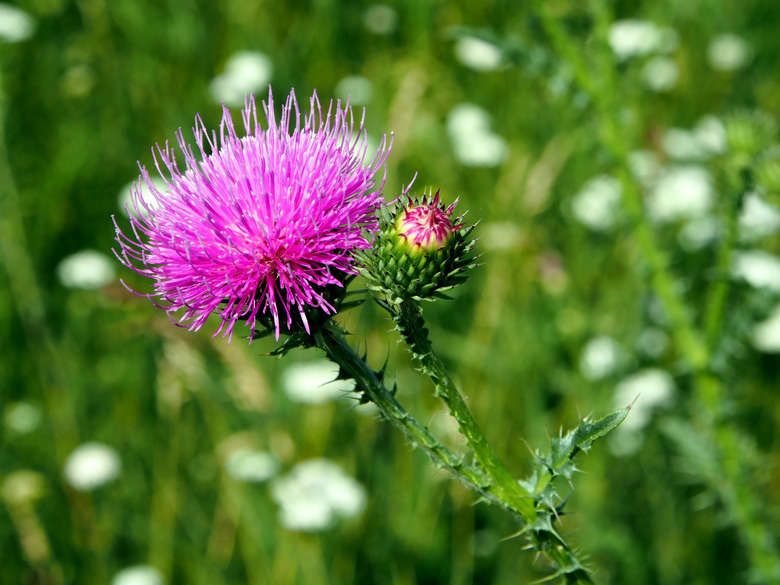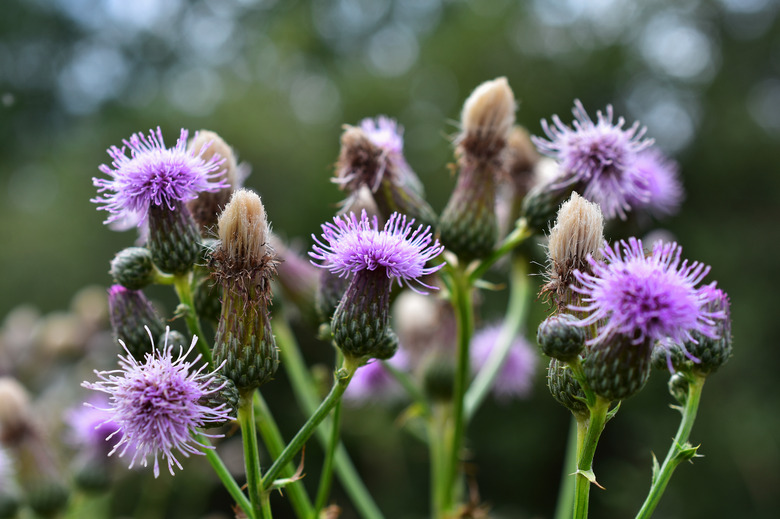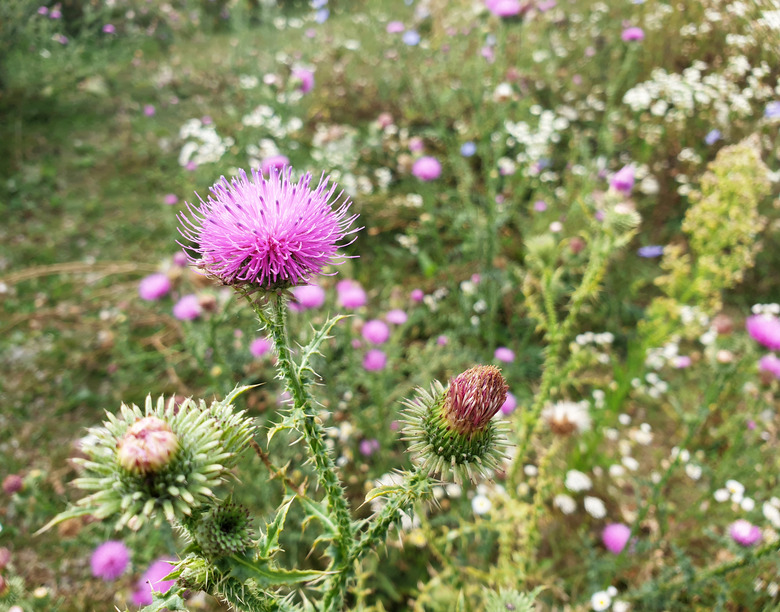How To Grow Milk Thistle
Milk thistle (Silybum marianum, USDA zones 5-10) is a biennial flowering plant with medicinal properties. It's ultra easy to grow, but there's a caveat — in many places, milk thistle is considered to be extremely invasive. Because it behaves much like a weed, it can quickly overtake other plants nearby. Milk thistle plants grow quite large — up to 3 feet tall and sometimes as wide as 4 feet. Additionally, the flower stalks can reach heights of up to 5 feet. Each stalk produces multiple flowers.
Milk thistle produces pretty purple flowers atop spiky heads and features bright-green foliage with white marbling. It's very forgiving about where you plant it and will tolerate most conditions. It's particularly fond of growing in rocky, dry areas, which makes sense considering its Mediterranean origins.
While milk thistle's adaptability makes it a cinch to grow, it's also what makes it invasive. The plant is not native to North America and quickly outcompetes other plants for space and nutrients. In some locations, growing milk thistle is actually illegal because of its ability to spread and wreak havoc on ecosystems. A single plant can produce thousands of seeds. While many edible plant seeds don't stay fresh for long (especially if left in non-ideal conditions), milk thistle seeds can remain viable for almost a decade. Milk thistle is very cold-hardy and challenging to eradicate once established because it produces deep taproots and dense foliage. It's also toxic to many animals, and when it ends up in pastures, it can poison livestock.
Not all thistles are invasive, though. There are several native thistle species that deliver some of the benefits of milk thistle without all the harm. Unfortunately, people sometimes kill native species because they assume they're invasive weeds. What's the difference between invasive milk thistle and native thistle plants? Milk thistle has very obvious white markings on its foliage that native species do not. Sadly, there are several other non-native, invasive thistle species that have established themselves in North America, including Canada thistle (Cirsium arvense), Italian plumeless thistle (Carduus pycnocephalus) and bull thistle (Cirsium vulgare).
Why would you grow milk thistle? Some people are interested in its medicinal properties. If you want to add milk thistle to your medicinal herb garden, be sure to check local regulations before planting something that's considered invasive.
Best Uses for Milk Thistle
The main draw of growing milk thistle is for the plant's notable medicinal qualities. Milk thistle plants contain a compound called silymarin, which has some well-known health benefits, including anti-inflammatory and anti-oxidant properties. Milk thistle is also a proven antidote for certain poisonous mushrooms.
All parts of the milk thistle plant are edible, from the roots to the flowers. You should carefully trim off the spines on the foliage and stems before eating them. Young taproots and flowers are also edible, as are the seeds. The flowers are most commonly harvested in order to get to the seeds.
Although the plant is considered edible, you should take care when adding it to your diet. In some soils, milk thistle can become high in nitrates, which are linked to stomach cancers. People with certain conditions, such as diabetes, should also avoid ingesting milk thistle. Some side effects of eating milk thistle include headache, nausea and upset stomach. Research suggests that milk thistle has protective qualities concerning the liver. However, people with liver problems should talk to their doctor before ingesting milk thistle.
Another reason to incorporate milk thistle in your garden is to attract pollinators. The pinkish-purple flowers are very attractive to bees and certain pollinating flies. Unfortunately, milk thistle has an aggressive spreading habit, so you'll need to take care to prevent the plant from becoming invasive. Ultimately, native thistles are a better choice for pollinator gardens. You should also avoid planting milk thistle in areas that are easily accessible to pets and children. The plants have a ton of sharp spikes that can wound curious noses and fingers.
Instead of planting directly in the ground, opt to grow milk thistle in containers. Growing in pots may stifle milk thistle plants' aggressive growth habit and prevent them from overwhelming your garden. You'll need reasonably deep pots to accommodate the plants because they have such a long taproot. However, growing in containers isn't a foolproof solution for avoiding self-sowing. The seeds spread in a variety of ways, including via wind and animals.
How to Grow Milk Thistle
Remember that milk thistle is considered a noxious weed in many areas of North America. It is also considered an invasive species in Australia. Do your due diligence before planting this medicinal plant in your garden.
Starting Milk Thistle From Seed
Start seeds indoors several weeks before your last frost date. You can direct-seed in the early spring if the soil is workable. It will take up to 20 days for the seeds to germinate. Once sprouted, thin plants to about 2 to 3 feet apart. Plants also self-seed quite easily. To prevent unwanted spread, do not let milk thistle go to seed. Remove the flowers as soon as they wilt and brown.
Tip
Note that most seed suppliers will not ship milk thistle seeds to certain states, such as Washington, Oregon and Texas.
In What Zone Does Milk Thistle Grow Best?
Milk thistle isn't native to North America, but it tends to grow best in zones 6 to 9. It's very cold hardy, so there's no need to protect it from frost. Even if plants die off in the winter (which will happen in colder zones), they self-sow readily. New plants will inevitably return the following year. These qualities sound great, but they're also what make milk thistle plants so invasive.
When Should You Plant Milk Thistle?
Milk thistle takes a few months to go from sprout to flower. Plant it in the early spring when the soil is workable. In zone 6, for instance, this would be sometime in late March. This is a weed, though, so timing isn't as crucial as it is with other more tender, cold-sensitive plants.
Soil, Sunlight and Water Recommendations for Milk Thistle
Milk thistle likes full sun but isn't picky at all about soil conditions. Its tolerability for multiple soil types make it a formidable weed. It's drought-tolerant, too. In most locations, rainfall is enough to keep the plant happy.
How to Harvest Milk Thistle
Be very careful when handling milk thistle. The plants are covered in very sharp spines. Wear gloves to prevent accidental puncture wounds.
To harvest the seeds, remove the flowers once they start to turn brown. This will probably happen in the late summer or autumn. Cut a sizable chunk of the stem along with the flower to make handling easier. Once you're done cutting off the flowers, toss them into a paper bag and allow them to dry out. The drying process can take up to two weeks.
When it's complete, the seeds will easily fall out of the flower heads with a bit of a shake. If some seeds are still stuck inside, carefully use a knife to dislodge them. Once the seeds are extracted from the flowers, continue the drying process for another week or so. When the second drying step is done, put the seeds in an airtight container.
To make milk thistle tea, grind the seeds in a coffee grinder. Add approximately 1 tablespoon of the ground powder per cup of water. Don't add the seed powder directly to the water. Use a tea bag instead. The tea should have a slightly nutty flavor. It's a pleasant-tasting drink with the added bonus of medicinal benefits. As with any kind of herbal supplement, always talk to your doctor before ingesting milk thistle. Some supplements may interact with medications.
Common Pests and Other Problems for Milk Thistle
As a weed, milk thistle doesn't have many problems. It's usually the problem for other plants! However, slugs and snails are often attracted to its weedy growth. That said, most resources actually list milk thistle as a pest itself, so consider whether it's worth planting in your garden for this reason.
There is a beetle called the thistle-head weevil that is used by multiple states to control milk thistle plants. The weevil is also non-native. Its larvae eventually hatch and eat the thistle plant's seeds, which prevents the plant from self-sowing. Unfortunately, this beetle will attack a variety of noninvasive thistle species in addition to milk thistle.


